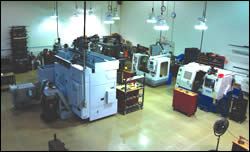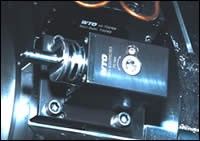Two-Man Shop Runs Unattended With Automated Turning Center
After investing in a gantry-loaded turning center equipped with machine-mounted gaging system, this two-man shop nearly tripled its productivity.
Share




For both small and large manufacturers, integrating automated machining processes can decrease costs while improving productivity, flexibility and product quality. However, smaller shops often struggle with the question of just how much automation is necessary for their operation. That’s why these shops often integrate automation incrementally. A case in point is Pfeifer Industries in Naperville, Illinois. The two-man operation started with a turn/mill machine fed by a gantry robot and soon moved to automated, on-machine part measurement. This has allowed the company to not only increase efficiency, but also run lights-out by ensuring part accuracy during unattended production.
Pfeifer specializes in mechanical power transmission components. In 2004, the company underwent a dramatic transition when its founder unexpectedly passed away. Brian Nass, a longtime employee, and Jim Donovan, a family friend, decided to purchase the shop. Having spent more than 15 years at Pfeifer, Mr. Nass possessed the machining knowledge necessary to manage the production side of the business. Mr. Donovan, on the other hand, had experience in running front-house operations such as accounting and engineering.
“I knew the key to being successful was getting the shop up and running as quickly as possible,” Mr. Donovan says. “Brian and I wear all the hats necessary to run Pfeifer Industries as a lean manufacturing and distribution company.”
Initially, the new owners were able to reestablish the company with its existing technology and equipment. Soon, however, it became apparent that the production process needed an overhaul to keep up with customer demand. With jobs consisting of a wide variety of parts in small batch sizes, the shop needed quicker setup times and higher productivity.
On the shop floor, two parallel production lines are used for different types of jobs, which can range from a one-off custom part for a competitive racer to a 1,000-piece production run for an industrial customer. In the past, Mr. Nass would work at one line while the other sat idle. Seeking a more efficient solution, the shop invested in a Mori Seiki NL2000 SMC turning center with a gantry loader. Automated part handling via the gantry loader has significantly reduced the need for operator intervention, enabling Mr. Nass to maintain both production lines simultaneously.
One job that exemplifies the time savings Pfeifer has garnered from the new machine involves a timing belt pulley machined from 12L14 carbon steel. The previous process involved turning one end of the part before manually removing and rechucking it to machine the other end. The part was then transferred to a machining center for milling and drilling. In all, the job required 3 minutes and 15 seconds of turning and 4 minutes and 8 seconds of milling.
With the NL2000’s subspindle and built-in milling motor, however,
the shop can now fully machine the component in 5 minutes and 20
seconds, a cycle time reduction of approximately 28 percent.
Additionally, because the machine can automatically pull pre-cut
barstock from the gantry loader, Mr. Nass now spends roughly 10 minutes
per hour in front of the turning center — a significant
improvement compared with the previous process, which required constant
operator attention. This leaves him more time to spend at other
workstations.
Encouraged by its success with the new machine, Pfeifer sought to implement additional automation to better accommodate its customers. “In addition to our timing belt pulleys, many of our customers were coming to us to machine high-tolerance, complex parts that had previously been sourced to other vendors,” Mr. Donovan says. “We wanted to leverage the advantages that the Mori provided us to meet their needs while still being able to produce our mainstay parts.”
So, the company experimented with unattended production on nights and weekends. However, without a means to monitor part quality during lights-out operation, tool wear could cause jobs to fall out of the typical required tolerances of 0.0004 inch. To address this issue, Pfeifer again turned to Mori Seiki and became the first U.S. company to receive the builder’s Hydrogage monitoring system.
The device operates similarly to an air gage but uses high-pressure coolant instead. A plug mounted on the machine’s turret is inserted into a part feature, and high-pressure coolant is forced through the small gap between the part and plug. The machine’s software calculates part dimensions by measuring the resistance to the coolant flow. According to the manufacturer, part measurement takes 3 seconds, and repeatability has been tested to 0.000077 inch.
The gage is said to work well for lights-out machining. One reason is if the bore size or OD of a part deviates from a predetermined tolerance, the system can maintain the required accuracy levels by automatically adjusting offsets or selecting a new tool. It also can be programmed to recut parts, manage statistical quality control (SQC) and measure parts at any desired interval.
Machined from quick-change tool blanks, the inexpensive gage plugs are a particular benefit for Pfeifer, Mr. Donovan says. “We can easily afford to have gage plugs for each of our part sizes, and change-over between batch runs is as simple as changing a tool and running the calibration program. On top of that, I don’t have to worry about the potential of crashing a $12,000 touch probe when running lights-out.”
In addition to cycle time reductions, the combination of the gantry loader and Hydrogage has more than doubled Pfeifer’s potential machining hours. The shop can now achieve steady production of 252 parts per day, compared with 87 parts per day in the past. As with most manufacturers, fixed costs make up the majority of Pfeifer’s total costs, and nearly tripling production has allowed the company to spread those fixed costs over a greater quantity of parts. The net result is that cost per part has been reduced by more than 70 percent.
“With the new
system, our biggest challenge is keeping our parts conveyor filled,”
Mr. Donovan says. “That’s a great place to be.”
Read Next
5 Rules of Thumb for Buying CNC Machine Tools
Use these tips to carefully plan your machine tool purchases and to avoid regretting your decision later.
Read MoreSetting Up the Building Blocks for a Digital Factory
Woodward Inc. spent over a year developing an API to connect machines to its digital factory. Caron Engineering’s MiConnect has cut most of this process while also granting the shop greater access to machine information.
Read MoreBuilding Out a Foundation for Student Machinists
Autodesk and Haas have teamed up to produce an introductory course for students that covers the basics of CAD, CAM and CNC while providing them with a portfolio part.
Read More

























.png;maxWidth=300;quality=90)







